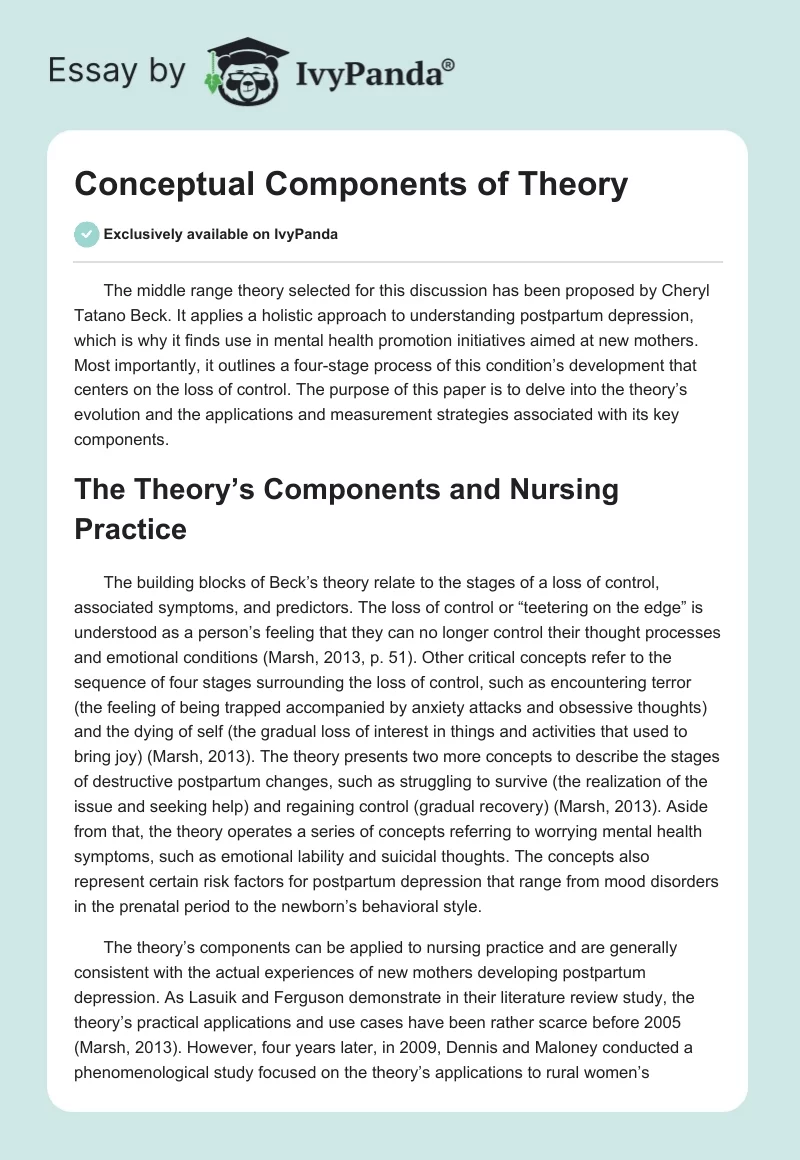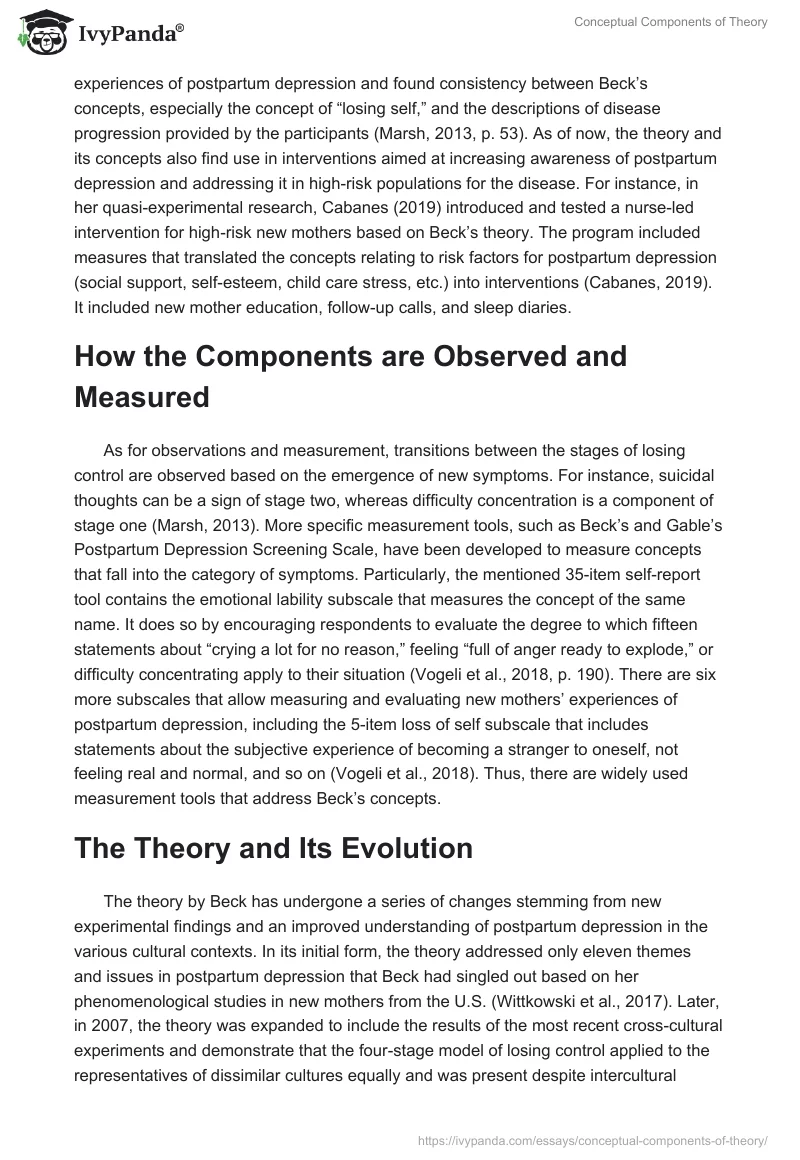The middle range theory selected for this discussion has been proposed by Cheryl Tatano Beck. It applies a holistic approach to understanding postpartum depression, which is why it finds use in mental health promotion initiatives aimed at new mothers. Most importantly, it outlines a four-stage process of this condition’s development that centers on the loss of control. The purpose of this paper is to delve into the theory’s evolution and the applications and measurement strategies associated with its key components.
The Theory’s Components and Nursing Practice
The building blocks of Beck’s theory relate to the stages of a loss of control, associated symptoms, and predictors. The loss of control or “teetering on the edge” is understood as a person’s feeling that they can no longer control their thought processes and emotional conditions (Marsh, 2013, p. 51). Other critical concepts refer to the sequence of four stages surrounding the loss of control, such as encountering terror (the feeling of being trapped accompanied by anxiety attacks and obsessive thoughts) and the dying of self (the gradual loss of interest in things and activities that used to bring joy) (Marsh, 2013). The theory presents two more concepts to describe the stages of destructive postpartum changes, such as struggling to survive (the realization of the issue and seeking help) and regaining control (gradual recovery) (Marsh, 2013). Aside from that, the theory operates a series of concepts referring to worrying mental health symptoms, such as emotional lability and suicidal thoughts. The concepts also represent certain risk factors for postpartum depression that range from mood disorders in the prenatal period to the newborn’s behavioral style.
The theory’s components can be applied to nursing practice and are generally consistent with the actual experiences of new mothers developing postpartum depression. As Lasuik and Ferguson demonstrate in their literature review study, the theory’s practical applications and use cases have been rather scarce before 2005 (Marsh, 2013). However, four years later, in 2009, Dennis and Maloney conducted a phenomenological study focused on the theory’s applications to rural women’s experiences of postpartum depression and found consistency between Beck’s concepts, especially the concept of “losing self,” and the descriptions of disease progression provided by the participants (Marsh, 2013, p. 53). As of now, the theory and its concepts also find use in interventions aimed at increasing awareness of postpartum depression and addressing it in high-risk populations for the disease. For instance, in her quasi-experimental research, Cabanes (2019) introduced and tested a nurse-led intervention for high-risk new mothers based on Beck’s theory. The program included measures that translated the concepts relating to risk factors for postpartum depression (social support, self-esteem, child care stress, etc.) into interventions (Cabanes, 2019). It included new mother education, follow-up calls, and sleep diaries.
How the Components are Observed and Measured
As for observations and measurement, transitions between the stages of losing control are observed based on the emergence of new symptoms. For instance, suicidal thoughts can be a sign of stage two, whereas difficulty concentration is a component of stage one (Marsh, 2013). More specific measurement tools, such as Beck’s and Gable’s Postpartum Depression Screening Scale, have been developed to measure concepts that fall into the category of symptoms. Particularly, the mentioned 35-item self-report tool contains the emotional lability subscale that measures the concept of the same name. It does so by encouraging respondents to evaluate the degree to which fifteen statements about “crying a lot for no reason,” feeling “full of anger ready to explode,” or difficulty concentrating apply to their situation (Vogeli et al., 2018, p. 190). There are six more subscales that allow measuring and evaluating new mothers’ experiences of postpartum depression, including the 5-item loss of self subscale that includes statements about the subjective experience of becoming a stranger to oneself, not feeling real and normal, and so on (Vogeli et al., 2018). Thus, there are widely used measurement tools that address Beck’s concepts.
The Theory and Its Evolution
The theory by Beck has undergone a series of changes stemming from new experimental findings and an improved understanding of postpartum depression in the various cultural contexts. In its initial form, the theory addressed only eleven themes and issues in postpartum depression that Beck had singled out based on her phenomenological studies in new mothers from the U.S. (Wittkowski et al., 2017). Later, in 2007, the theory was expanded to include the results of the most recent cross-cultural experiments and demonstrate that the four-stage model of losing control applied to the representatives of dissimilar cultures equally and was present despite intercultural differences (Wittkowski et al., 2017). In her additional remarks, the theorist also mentioned the opportunity to modify her theory to capture the “cross-cultural experiences” of postpartum depression (Wittkowski et al., 2017, p. 412). Considering this, the testing of the theory’s main concepts in different populations led to new information regarding postnatal depression and its mechanisms as experiences that are not unique to particular cultures.
Conclusion
Finally, Beck’s theory has been developed in order to explore the phenomenon of postpartum depression and place relationships between different relevant concepts and symptoms in the context of practice. The theory informs the development of nurse-led interventions for the prevention of postpartum depression in high-risk populations. It includes more than twenty concepts that are measured and observed by keeping track of the emergence of new symptoms and the use of specific tools, such as the PDSS.
References
Cabanes, R. V. D. (2019). Mental health promotion program to enhance maternal adjustment among postpartum women. UERM Health Sciences Journal, 8(1), 63-71.
Marsh, J. (2013). A middle range theory of postpartum depression: Analysis and application. International Journal of Childbirth Education, 28(4), 50-54.
Vogeli, J. M., Hooker, S. A., Everhart, K. D., & Kaplan, P. S. (2018). Psychometric properties of the postpartum depression screening scale beyond the postpartum period.Research in Nursing & Health, 41(2), 185-194. Web.
Wittkowski, A., Patel, S., & Fox, J. R. (2017). The experience of postnatal depression in immigrant mothers living in Western countries: A meta-synthesis. Clinical Psychology & Psychotherapy, 24(2), 411-427.


